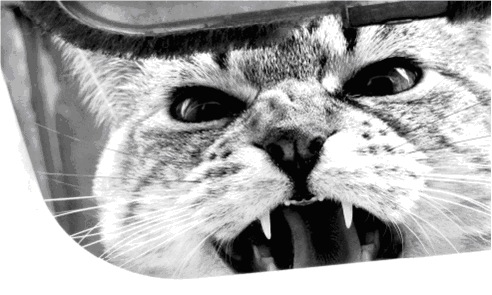Understanding Aggressive Behavior in Cats

Aggression is a serious problem that can result in injury to other animals and people. In addition, zoonotic diseases can be spread from cats to people through aggressive acts. Although not a common complaint, aggression is commonly seen in the form of play behavior in kittens. Understanding the cat's normal social behavior, body postures,and facial expressions can prevent much aggression.
Preventing aggression towards humans
Aggression caused by lack of socialization
There is increased risk of aggression towards humans if cats did not have human contact during the sensitive periods. Cats that are not handled until 14 weeks of age are more fearful and aggressive toward people, regardless of the circumstances.
Such cats do not voluntarily approach humans and are aggressive if they cannot escape. In contrast, cats handled for as little as 5 minutes per day from the day they are born until they are 7 weeks of age are quicker to approach and solicit people for interaction and gentle play, quicker to approach inanimate objects, and quicker to play with toys.
Socializing cats to a variety of people, including men, women, and children, may prevent some forms of human-directed aggression. If possible, expose kittens to humans before the kitten is 7 weeks old. Have the queen present, provided she is not afraid. Handling by people should be frequent, pleasant, and gentle. Include handling that mimics basic health care procedures, including clipping claws, checking ears, and brushing teeth. If an adult cat has not been exposed to such handling as a kitten, start with very brief sessions. Reward the cat for cooperation.
Play aggression - Kittens often play roughly with other cats or kittens. The queen and other kittens teach the kitten to temper their play. Cats that as kittens never learn to moderate their responses may play too aggressively with people. Use interactive toys (eg, a fishing pole-type toy with fabric or feathers at the end of it) instead of letting the kitten play directly with your hands or feet. Adult supervision is essential when children play with and handle kittens and cats; this supervision will prevent injury to all involved.
Fear/Defensive aggression - Cats who are fearful may display body postures which appear to be similar to canine submissive postures-crouching on the floor, ears back, tail tucked, and possibly rolling slightly to the side. Cats in this posture are not submissive, they are fearful and defensive and may attack if touched.
Aggression associated with petting - Some cats become less tolerant of petting as they become socially mature. Cats with this condition actually solicit attention from people, but tend to bite if petted for more than a few seconds. Those cats may have a form of impulse control aggression. Such aggression can be avoided if the owner learns to give those cats attention in other ways, pet the cat for very short periods, or both.
Redirected aggression - If a cat is highly aroused by an outdoor cat or other animal, the cat may redirect that aggression toward anyone nearby. This victim could be another household cat with which there had been no previous problems or an unsuspecting family member. Never attempt to handle a cat in this aroused state, because serious injury may result. If one cat is attacking another, a noise can distract or startle the attacker and interrupt the event. However, some cats will be rendered more aggressive by these stimuli, so caution is urged in using any disruptive stimulus. If cats must be handled while in this reactive state, throwing a blanket over them can allow safe handling to occur.
Pain-associated aggression - Pain can cause aggression. A cat may attack an individual who causes pain (eg, a person combing over arthritic hips or brushing a painful tooth) or have lower tolerance because of preexisting pain. Because painful conditions such as arthritis, dental disease, intervertebral disk disease, meningioma, or injury often induce aggression, clients are strongly encouraged to immediately make an appointment for a cat that becomes aggressive suddenly.
Predatory behavior - Cats are hunters and will go after prey even if not hungry. The best way to prevent predatory behavior is to raise kittens with potential prey animals (eg, pocket pets or birds). Even if cats are not aggressive, clients should supervise them whenever they have access to potential prey. To prevent predation of wildlife, keep cats indoors, confine them to outdoor cat enclosures, or leash-walk them. Placing bells on the collars of free roaming cats does not always prevent predation because cats can learn to stalk without the bell ringing.
Remember that predatory behavior may take the form of chasing moving objects, like shoe laces, yarn, or other dangling/moving items. The best way to stop this is to stop the movement and redirect the cat's attention to a proper toy or treat.
Inter-cat/territorial aggression - Aggression between cats within the same household is not uncommon, however, unless there is evidence of wounds, people often miss subtle aggression. Aggressors can control access to food, litter boxes, resting and perching spots, and attention, and the victim usually becomes withdrawn. Both the aggressor and the victim may have undesirable elimination and other behaviors.
Inter-cat aggression is most likely to occur when a new cat is introduced to a household, a resident cat has been absent and returns to the home (eg, after a veterinary visit), or when there is competition for resources (eg, litter boxes, food, and resting areas). Multiple resources should be easily accessible.
To prevent inter-cat aggression, gradual introductions should be made if adopting another cat. If aggression occurs after the return to the household of a resident cat, the cats should also be reintroduced gradually.
Pheromone products can help reduce aggression when unfamiliar cats are introduced to existing residents. Although these products may be helpful as part of a complete behavior treatment plan, they are not a substitute for social interaction and exposure.
What You Can Do
First, make an appointment with your veterinarian to rule out medical causes for the aggressive behavior.
Seek professional help. An aggression problem will not go away by itself. Working with aggression problems requires extensive help from an animal behavior specialist.
Take precautions. Your first priority is to keep everyone safe. Supervise, confine and/or restrict your cat's activities until you can obtain professional help. You are liable for your cat's behavior.
Avoid exposing your cat to situations where he is more likely to show aggression. You may need to keep him confined to a safe room and limit his people-contact.
What Not To Do
Punishment won't help and, in fact, will make the problem worse.
If you punish your cat for growling, hissing, or slapping, he may stop giving those warnings and go to clawing or biting. If the aggression is motivated by fear, punishment will make your cat more fearful, and therefore more aggressive. Punishing territorial, possessive or protective aggression is likely to elicit additional defensive aggression.
Don't encourage aggressive behavior by playing roughly with your cat, pushing him with your hands or allowing the cat to put his mouth on you.
Many times, what is thought to be 'aggressive' behavior is truly just the cat's way of communicating his fear and anxiety. Sometimes, all it takes is some positive reinforcement training to help build the cat's confidence in certain situations. Please call us if you are having any behavior trouble with your cat. The only way to fix a problem is to address it and we can help.
Adapted from material developed by
Dumb Friends League and the Humane Society of the
















